Wondering how the perfect shade of eyeshadow is crafted? This journey from powder to palette is not only fascinating but crucial for anyone looking to dive into the cosmetics industry.
With years of experience in the eyeshadow manufacturing sector, I have gathered insights and knowledge that are invaluable for businesses looking to understand the complexities of cosmetic production.
Eyeshadow manufacturing combines artistry with science, transforming simple ingredients into a palette of colors that captivate consumers worldwide.
In this ultimate guide, we’ll explore the 7 key steps involved in creating eyeshadows that stand out in the competitive beauty market.
Read on to uncover the secrets!
Before diving into the tangible process of eyeshadow manufacturing, the journey begins with an idea. Conceptualization and design are the foundations. Here are the crucial steps to bring your vision to life:
The first critical step in the conceptualization phase of eyeshadow manufacturing is conducting thorough market research and trend analysis. This involves diving deep into understanding current market demands, identifying popular colors, exploring various textures, and analyzing what competitors are doing. Such detailed insights are pivotal for spotting gaps in the market and predicting upcoming trends.

With a wealth of market insights at hand, the next stage in eyeshadow manufacturing is to develop the concept. This critical step requires deciding on the eyeshadow palette’s color scheme, textures, and overall theme. In fact, it’s about creatively converting the gathered market needs and aesthetic trends into a tangible product concept that will captively speak to the intended audience.
Prototype creation marks the final step in the design process of eyeshadow manufacturing. This involves crafting a small batch of the eyeshadow, which is essential for testing various aspects such as formulation, color accuracy, and packaging. Prototyping is an indispensable phase for assessing the product’s physical appeal and functional performance.
Transitioning from the creative conceptualization and design phase, the next critical step involves the selection of pigments and materials. Let’s break down the thorough process involved in choosing the right components:
The selection process in eyeshadow manufacturing begins with understanding the different types of pigments available. These can range from natural or organic pigments derived from minerals to synthetic ones designed for vibrant colors and longevity. Aside from that, each pigment type has its unique properties, such as opacity, shimmer, and texture, which can significantly affect the final eyeshadow appearance and performance.
After identifying the types of pigments, assessing their quality is crucial. High-quality pigments ensure that the eyeshadow has excellent color payoff, blends well, and is long-lasting. Factors such as purity, fineness, and color consistency are evaluated to ensure that only the best pigments are used. Nako Cosmetics prioritizes sourcing premium pigments that meet these strict criteria to maintain its reputation for quality products.
The final step in selecting pigments and materials is ensuring they meet safety and regulatory standards. This involves checking for any potential allergens or harmful substances and ensuring compliance with cosmetic regulations in your target markets for the eyeshadow. Similarly, it must be approved by Good Manufacturing Practices (GMP) and the Food and Drug Administration (FDA) to protect clients and build trust in your brand.
After selecting the perfect pigments and materials, the next step is creating the base. Let’s explore the detailed process involved in crafting a flawless base for the eyeshadow palette:
The binder is what holds the pigments together and to the skin. Selecting the right binder is crucial for the eyeshadow’s texture and durability. As an example, whether your brand is aiming for a matte, shimmer, or glitter finish, the binder affects how the eyeshadow adheres to the skin and its resistance to creasing or fading.
Fillers are used to achieve the desired consistency and volume without compromising the pigment’s intensity. The truth is that they can also affect the eyeshadow’s smoothness and how it blends on the skin. The balance of fillers must be carefully managed to ensure the eyeshadow has a silky, even application and doesn’t look chalky or feel heavy on the eyelid.
To ensure the eyeshadow’s longevity and safety, preservatives and additives are added to the base. These ingredients prevent the growth of bacteria and mold extending the product’s shelf life. Additionally, additives can enhance the product’s texture and feel contributing to a luxurious user experience. Nako Cosmetics incorporates carefully selected preservatives to guarantee their eyeshadows remain safe and high-quality.
Here’s a table that outlines the importance of adding preservatives and additives in the production of eyeshadows by Nako Cosmetics:
| Aspect | Description | Benefit |
| Preservatives | Ingredients added to prevent the growth of bacteria and mold, ensuring the product’s safety. | Safety and Longevity: Extends the shelf life of eyeshadows, ensuring they remain safe for use over time. |
| Additives | Compounds that enhance the texture, feel, and overall application experience of the eyeshadow. | Luxurious Experience: Contributes to a smoother, more enjoyable application, enhancing user satisfaction. |
| Careful Selection | Nako Cosmetics selects preservatives and additives with consideration for safety and efficacy. | Quality Assurance: Guarantees that eyeshadows meet high standards of safety and performance. |
| Product Shelf Life | The inclusion of these ingredients significantly extends the usable life of the eyeshadow. | Economic Value: Provides consumers with a product that maintains quality over time, offering better value for their investment. |
| User Experience | Additives are chosen to improve the sensory aspects of the eyeshadow, like its feel on the skin. | Enhanced Satisfaction: Ensures a positive and satisfying application experience for the user. |
Once the base is created, thorough testing is conducted to ensure consistency and quality across batches of the eyeshadow. This includes testing for color payoff, blendability, and adherence to the skin. A thorough testing of the consistency of the eyeshadow is key to maintaining brand reputation and customer satisfaction, making this step a critical part of the base creation process.
With the base now ready, the focus shifts to one of the most critical stages in eyeshadow manufacturing which is the mixing and milling. Let’s see the following steps involved in this phase:
The initial step involves thoroughly mixing the chosen pigments with the base. This homogenization process is crucial for dispersing the pigments evenly throughout the base, ensuring that each swipe of eyeshadow delivers consistent color and quality. The goal here is to achieve a mixture where no single pigment dominates, but rather, all components are equally represented.
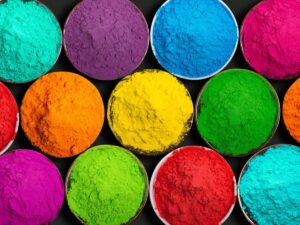
After mixing, the eyeshadow mixture undergoes milling. Milling further breaks down the particles ensuring an even finer and smoother product. This step can significantly affect the eyeshadow’s final texture making it silkier and easier to apply. The milling process is adjusted depending on the desired outcome whether it’s a fine matte finish or a more textured glittery look.
As a matter of fact, the milling intensity can make or break an eyeshadow’s appeal. In some other brands, it is found that a slightly less intense milling process for the shimmer shades allows for a more luxurious, dimensional finish. There will be some subtle adjustments in manufacturing that can elevate the eyeshadow from good to exceptional.
After milling, doing another round of checks is essential to ensure the product meets the desired standards. This includes testing for texture consistency, color accuracy, and overall performance. It’s not uncommon to return to the mixing and milling stages for adjustments. This iterative process is done to refine the product to perfection, a testament to the dedication behind creating eyeshadows that truly stand out.
Following the mixing and milling process, the next stage in eyeshadow manufacturing is pressing and molding. This step transforms the finely milled powder into its solid, user-friendly form. Here are some key processes involved:
Before pressing can begin, the eyeshadow mixture must be prepared. This often involves ensuring the mixture has the right moisture content to bind together without being too wet or too dry. It is important to know that achieving the correct balance is crucial for the pressing process as it affects the eyeshadow’s compactness and durability.
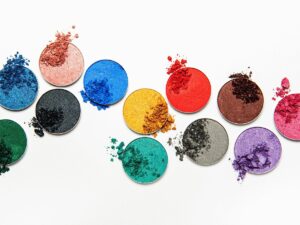
The prepared mixture is then placed into molds corresponding to the desired shape and size of the final eyeshadow product. A press machine applies a precise amount of pressure to compact the mixture into solid pans. The pressure level is carefully calibrated to ensure the eyeshadow is firm enough to hold its shape, yet soft enough to deliver a smooth application.
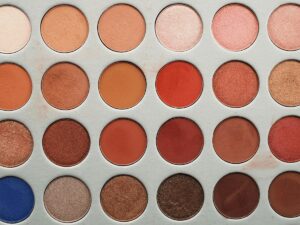
In my years of being in this industry, I have learned the importance of the pressing technique. Too much pressure and the eyeshadow becomes too hard, affecting its blendability. Too little, and it may crumble easily. It’s finding that sweet spot that creates a product that’s just right – a challenge that the team embraces with every batch.
After pressing and molding, ensuring the eyeshadow meets the highest standards is essential. Quality control and testing form the backbone of this assurance process. Here are the steps to guarantee that every palette not only meets but exceeds expectations:
The first line of defense in quality control is a thorough visual inspection. On top of that, each eyeshadow pan is examined for any imperfections, such as cracks, uneven surfaces, or color inconsistencies. This step ensures that only visually perfect products move forward in the process.
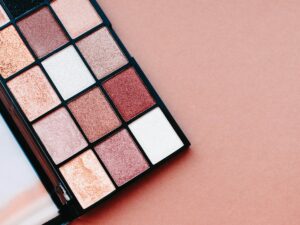
Beyond looks, the eyeshadow must perform exceptionally. This involves testing for color payoff, blendability, and longevity. Eyeshadows are applied and observed under various conditions to ensure they maintain their quality over time, resist creasing, and deliver the vibrant colors expected from their initial application.
An aspect that must be taken very seriously is the safety and comfort of all the clients. The industry’s panel has reviewed just 11 percent of the 10,500 cosmetic ingredients cataloged by the Food and Drug Administration (FDA 2000) according to EWG. It is a must that all products should undergo thorough safety and allergy testing to ensure they are free from harmful chemicals and minimize the risk of allergic reactions.
Once the eyeshadow passes all quality tests, the final step is packaging and branding. This stage is crucial for market appeal and brand recognition. Here are the key considerations in presenting the product to the world:
The design phase is where creativity meets functionality. This begins by sketching out designs that reflect the eyeshadow’s brand identity, ensuring that the packaging is not only visually appealing but also practical for everyone. For example, incorporating mirrors or applicators can enhance the experience, making the product more attractive and convenient.
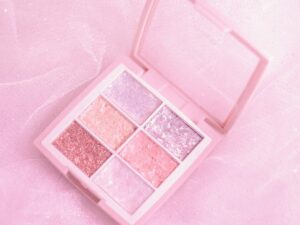
This step involves infusing every aspect of the packaging with the brand’s essence. From the color scheme and logo placement to the typography and pattern design, every detail is thoroughly planned to ensure brand consistency. It’s these elements that make the eyeshadows instantly recognizable on the shelves, fostering brand loyalty and recall.
Once the packaging design and materials are finalized, the next step is the assembly of the packaging with the eyeshadow pans. This process is done with precision and care, ensuring each palette is perfectly assembled without any defects. A final quality check is conducted on the packaged products, guaranteeing that they meet our high standards before they make their way to shelves and ultimately, to all clients..
Looking for more diverse product options? Browse through our handpicked selections:
Still haven’t found what you’re looking for? Don’t hesitate to contact us. We’re available around the clock to assist you.
Going through the eyeshadow manufacturing process from conceptualization to the final product is a complex journey. This guide provides a detailed roadmap, ensuring the venture into eyeshadow production is both informed and successful.
If you are interested in high-quality eyeshadows that stand out, explore Nako Cosmetics for a range of premium products tailored to your needs. To discover our collection and product offerings, contact us now!
Own Your Private Label Cosmetic Line Is No Longer Difficult Here!
Don't let questions and needs hold you back. Reach out to us today.
How to Start Your Beauty Business?